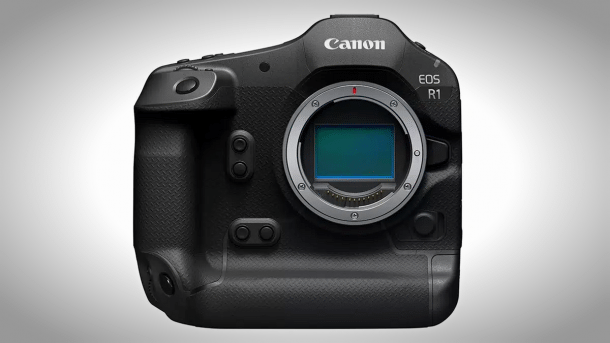Canon still plans to deliver flagship R1 in 2024
The successor to the R3 professional camera looks like its predecessor, but is said to work faster with AI autofocus. A lot of technical data is still missing.

The only picture of the Canon R1 so far - it looks very similar to the R3.
(Image: Canon)
- Nico Ernst
After Canon announced its new top-of-the-range EOS R1 camera over a year ago, the company has now presented the device in a little more detail and also given a vague date: The R1 is to be launched before the end of 2024, at an unknown price. Canon has not yet specified the exact date, but it can be assumed that professional photographers will be able to test the camera at the Olympic Games in Paris in a month's time.
In a brief press release on its international website and a post on its German-language site, Canon only shows the camera from the front in a low-resolution image and a very short video. It looks very similar to the R3 and, like most professional cameras, has two handles, one for portrait format shooting, including a second shutter button and other controls. The edging for these buttons is slightly different, and the rubberized coating no longer has the honeycomb pattern of the R3, but a checker plate design.
The frontal shot also shows the R1 without a cover for the sensor. Whether the camera has this, as is the case with other mirrorless models without a shutter, cannot yet be deduced from this. It is also still unclear whether Canon will do without a mechanical shutter at all, as the R3 still has one. Other top cameras such as Nikon's Z 9 and Sony's A9 III work with a purely electronic shutter.
AI accelerator as a separate chip
This enables them to achieve a higher frame rate. Canon is still keeping the R1's frame rate to itself, as well as the resolution of the sensor - which has been confirmed as a new development. Regarding the electronics, the company also states that in addition to an image processor from the well-known "DIGIC X" series, a coprocessor called "DIGIC Accelerator" is to be installed. This should ensure a higher processing speed and faster autofocus, even for videos.
Although Canon avoids the buzzword "artificial intelligence" in its announcement, it is clear from the reference to "deep learning" that this is precisely what the accelerator is supposed to do. Unlike its competitors, the new system should not only be able to focus on previously defined subjects, even if they are temporarily out of the field of view. Instead, the "Action Priority" function can be used to define a specific change in the image content as the focus point. Canon gives the example of "shooting a ball" - the R1, like other flagships, is therefore primarily designed for sports.
With a presumably higher continuous shooting speed than the 30 fps with electronic shutter with the R3, new lenses or firmware updates for existing ones are probably also due for full autofocus tracking. This was also the case with Sony's A9 III for its 120 fps. Canon has not yet provided any information on the speed of the R1, which also applies to the resolution of the sensor. This is considered to be particularly exciting, especially because Sony opted for a comparatively low 24 megapixels for the A9 III. On the other hand, the Alpha's sensor works with a global shutter, which, in addition to great speed, also avoids the well-known rolling shutter effects.
(nie)